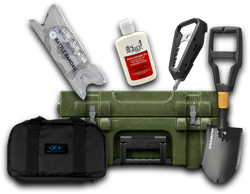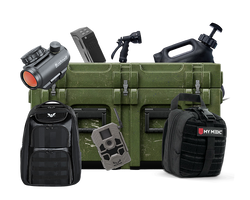
How To Prepare For Natural Disasters: A Comprehensive Checklist
Natural disasters can strike at any moment, leaving us vulnerable and unprepared. It
is crucial to have a comprehensive checklist in place. It will let you ensure the safety
and well-being of ourselves and our loved ones during these challenging times.
In this blog post, we will provide an easy-to-understand checklist for natural disaster
preparedness that covers the essential items you should have on hand to prepare for natural disasters.
A Comprehensive Checklist to Prepare for Natural Disasters
Water
Water is the most crucial resource to have during a natural disaster. It is recommended to have at least one gallon of water per person, per day, for a minimum of three days. Store water in clean, airtight containers and ensure you have enough for drinking, cooking, and hygiene purposes.
Food
Non-perishable food items are essential during a disaster when access to fresh food may be limited. Stock up on canned goods, dry snacks, and energy bars that have a long shelf life. Aim to have a three-day supply of food per person, and don't forget to include a manual can opener.
Battery Powered Radio
During a natural disaster, communication can become challenging. A battery-powered radio can be a lifeline to stay informed about weather updates, evacuation orders, and emergency instructions. Make sure you have extra batteries to power the radio for an extended period.
First-Aid Kit
Injuries are common during natural disasters, so having a well-stocked first-aid kit is crucial. Your kit should include adhesive bandages, antiseptic wipes, gauze pads, medical tape, pain relievers, and any necessary prescription medications. Familiarize yourself with basic first-aid procedures to handle minor injuries.
Flashlight
Power outages are common during natural disasters, so having a reliable flashlight is essential. Opt for LED flashlights that are energy-efficient and long-lasting. Keep extra batteries on hand or invest in rechargeable flashlights that can be powered with solar energy.
Extra Batteries
Apart from powering the radio and flashlight, extra batteries are needed for various other essential devices such as emergency cell phones, portable chargers, and other battery-operated equipment. Ensure you have a sufficient supply of batteries to last throughout the disaster.
Dust Mask
In certain natural disasters, such as wildfires or earthquakes, dust and debris can be a significant threat to your respiratory health. Protect yourself by having dust masks or N95 respirators on hand. These masks filter out harmful particles and ensure you can breathe easily in hazardous conditions.
Garbage Bag
A sturdy garbage bag can serve multiple purposes during a natural disaster. It can be used for waste disposal, as an emergency poncho, or as a makeshift shelter. Opt for heavy-duty garbage bags that are tear-resistant and waterproof.
Clothing
In the event of a disaster, having appropriate clothing is essential. Pack a set of sturdy and weather-appropriate clothing for each family member, including comfortable shoes, rain gear, and warm layers. Remember to consider the climate and weather conditions specific to your region.
Multi-Tool
A multi-tool is a versatile and compact tool that can be invaluable during a natural
disaster. It typically includes a knife, pliers, screwdrivers, and other useful tools. This tool can help you with various tasks, such as opening cans, repairing equipment, or cutting through debris.
Local Maps
During a disaster, navigation can become challenging, especially if roads and
landmarks are damaged or inaccessible. Keep local maps, including detailed street maps and topographic maps, in your emergency kit checklist. Familiarize yourself with evacuation routes and alternative routes to critical locations.
Cell Phones & Additional Batteries
Cell phones are essential for communication during emergencies. Make sure to have fully charged cell phones and keep additional batteries or portable chargers on hand. Consider storing emergency contact numbers, important documents, and important apps for weather updates and emergency alerts.
Personal Hygiene Items
Maintaining personal hygiene during a disaster is crucial for preventing illness and maintaining overall well-being. Pack items such as hand sanitizer, wet wipes, toilet paper, toothbrushes, toothpaste, and any other necessary hygiene products. Additionally, include any required medications or medical supplies specific to your family's needs.
Emergency Blanket
An emergency blanket, also known as a space blanket, is a lightweight and compact blanket that provides insulation and retains body heat. These blankets are essential for staying warm during power outages or when sheltering in place. They are typically made of reflective material to trap body heat effectively.
Plastic Sheeting and Duct Tape, If Necessary
In certain situations, such as chemical spills or airborne contaminants, it may be
necessary to shelter in place. Plastic sheeting and duct tape can be used to seal
windows, doors, and other openings to create a temporary barrier against harmful substances. Ensure you have enough plastic sheeting and duct tape to cover all necessary areas.
Quick Disaster Survival Tips to Know.
- During a disaster, it's important to be self-sufficient for a certain period. Stock up on essential supplies like non-perishable food, water, medication, and basic hygiene items. Aim for at least a three-day supply for each person in your household. Don't forget to include supplies for your pets as well.
- Familiarize yourself with safe places within your home or community for different types of disasters. Conduct regular practice drills with your family to ensure everyone knows what to do and where to go in case of an emergency.
- Stay informed and follow the instructions and guidelines provided by local authorities during a disaster. They are trained to assess the situation and provide the most accurate and up-to-date information.
- Monitor local news, emergency alerts, and official social media channels for updates and instructions.
Share this article








